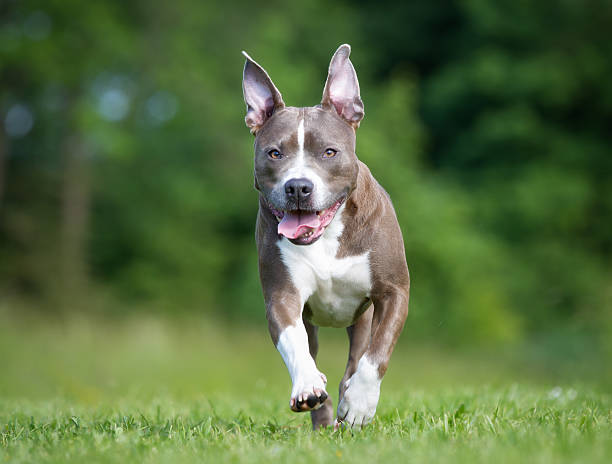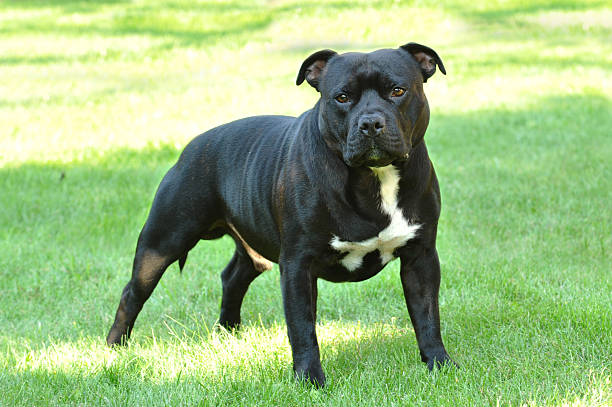American Staffordshire Terrier

Breed History:
The American Staffordshire Terrier, often called the AmStaff, descends from the 19th-century bull-and-terrier breeds developed in the United Kingdom for bull-baiting and dog fighting. When these dogs were brought to the United States, they were further developed into a more robust, companion-oriented breed.
By the early 20th century, the American variety diverged in size and temperament from the original Staffordshire Bull Terrier. In 1936, the American Kennel Club (AKC) recognised the breed as the Staffordshire Terrier, later renamed the American Staffordshire Terrier in 1972 to distinguish it from its British cousin. The AmStaff was bred to combine tenacity with loyalty and friendliness, evolving into a reliable companion and show dog.
|
Gender |
Height |
Weight |
|
Male |
46-48 cm |
25-32 kg |
|
Female |
43-46 cm |
18-25 kg |
Size – Medium
Life Expectancy: 12–15 years

Breed Appearance:
The American Staffordshire Terrier is muscular, compact, and powerful, with a broad head, well-defined jawline, and a short muzzle. Its eyes are round and dark, and the ears may be cropped or left natural (half-pricked or rose-shaped).
The short, smooth coat comes in a wide variety of colors, including solid, brindle, and combinations with white. The breed has a deep chest, strong shoulders, and a confident, agile gait. Despite its muscular build, the AmStaff has a graceful and balanced appearance.
Breed Type – Companion / Guard / Working:
Originally bred for strength and perseverance, the AmStaff is now recognized for its loyalty, courage, and affectionate nature. It is a devoted family companion, known for its love of children and strong bonds with its people.
The breed also excels in obedience, agility, and therapy work, and can serve as a protective watchdog. While confident and alert, a well-socialized AmStaff is generally outgoing and stable, not aggressive by default.

Training:
The AmStaff is intelligent, eager to please, and thrives with structured training. Early socialization and obedience training are essential to channel its energy and strength in positive ways.
It responds best to positive reinforcement methods—treats, praise, and consistency. Harsh or punitive techniques can damage trust and provoke unwanted behavior. This breed loves to work and enjoys mental stimulation, excelling in dog sports and structured tasks.
Health & Care:
The American Staffordshire Terrier is a generally healthy breed, though it can be prone to a few genetic conditions, including:
-
Hip and elbow dysplasia
-
Cerebellar ataxia (neurological disorder)
-
Skin allergies and demodectic mange
-
Hypothyroidism
-
Heart disease
Routine veterinary care, a balanced diet, and regular exercise are key to maintaining its health. Genetic testing through responsible breeders helps reduce the incidence of inherited conditions.

Living Conditions:
AmStaffs can adapt to both urban and suburban life if they receive enough daily activity and interaction. While they can live in apartments, they require regular exercise and mental engagement.
They are best suited to homes with secure fencing and owners who can provide structure, leadership, and attention. The breed prefers being close to its family and may develop separation anxiety if left alone for long periods.
Exercise:
The AmStaff is an energetic, muscular dog that needs at least 1 hour of physical activity each day. This can include walking, jogging, interactive play, tug-of-war, or agility training.
Mental stimulation—like puzzle toys, scent games, and obedience drills—is just as important as physical exertion. Without adequate exercise, the breed may become restless, vocal, or destructive.
Grooming:
The American Staffordshire Terrier has a low-maintenance, short coat that requires minimal grooming. Weekly brushing with a soft bristle brush or rubber mitt helps reduce shedding and maintain coat health.
Routine care includes nail trimming, ear cleaning, and dental hygiene. The breed is naturally clean and usually odour-free, requiring baths only when dirty or as needed.

Advantages:
-
Loyal and deeply bonded with family
-
Highly trainable and intelligent
-
Low grooming requirements
-
Excels in dog sports and obedience
-
Protective and alert without being overly aggressive
-
Good with children when properly socialised
Disadvantages:
-
Needs daily physical and mental stimulation
-
Not suitable for novice owners without firm guidance
-
May be reactive toward other dogs if poorly socialised
-
FACES breed-specific legislation (BSL) in some areas
-
Can develop separation anxiety if left alone too long
-
Strong and muscular—requires supervision around small pets

